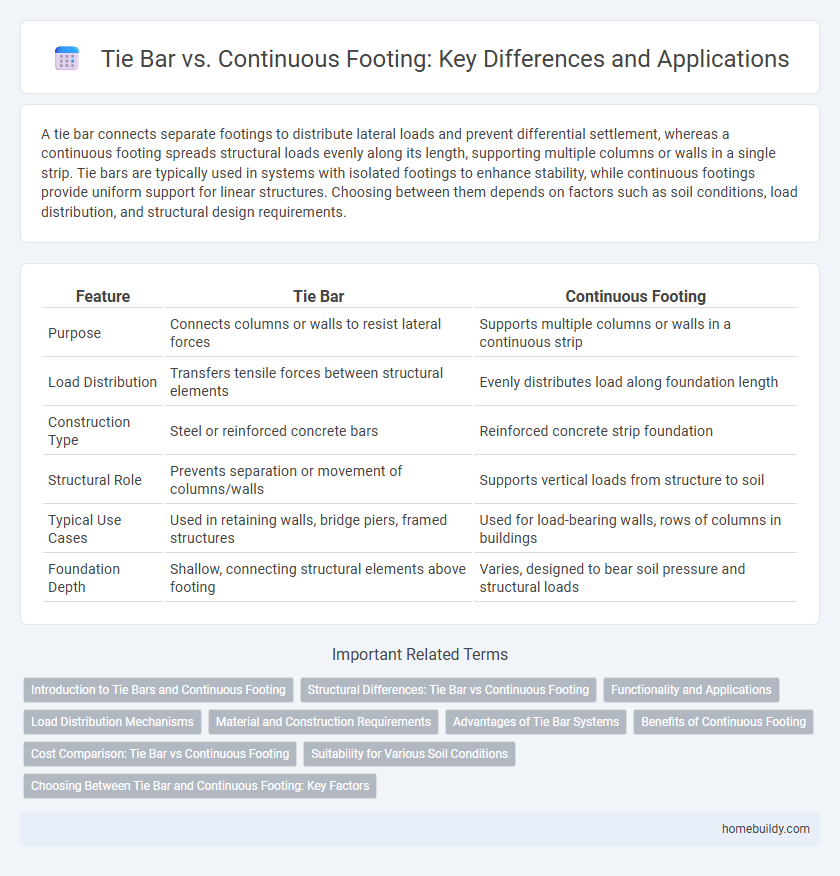A tie bar connects separate footings to distribute lateral loads and prevent differential settlement, whereas a continuous footing spreads structural loads evenly along its length, supporting multiple columns or walls in a single strip. Tie bars are typically used in systems with isolated footings to enhance stability, while continuous footings provide uniform support for linear structures. Choosing between them depends on factors such as soil conditions, load distribution, and structural design requirements.
Table of Comparison
| Feature | Tie Bar | Continuous Footing |
|---|---|---|
| Purpose | Connects columns or walls to resist lateral forces | Supports multiple columns or walls in a continuous strip |
| Load Distribution | Transfers tensile forces between structural elements | Evenly distributes load along foundation length |
| Construction Type | Steel or reinforced concrete bars | Reinforced concrete strip foundation |
| Structural Role | Prevents separation or movement of columns/walls | Supports vertical loads from structure to soil |
| Typical Use Cases | Used in retaining walls, bridge piers, framed structures | Used for load-bearing walls, rows of columns in buildings |
| Foundation Depth | Shallow, connecting structural elements above footing | Varies, designed to bear soil pressure and structural loads |
Introduction to Tie Bars and Continuous Footing
Tie bars are reinforcement components used to connect individual footings, enhancing structural stability by distributing loads and preventing differential settlement. Continuous footing is a type of foundation that extends continuously under multiple columns or walls, providing uniform support across the structure. Understanding the interaction between tie bars and continuous footing is essential for optimizing foundation design and ensuring load transfer efficiency.
Structural Differences: Tie Bar vs Continuous Footing
Tie bars are steel reinforcement components used within concrete to resist tensile forces, ensuring structural integrity by linking separate elements, while continuous footings are concrete foundations that distribute building loads evenly across the soil. Unlike continuous footings, tie bars do not support vertical loads directly but function primarily to prevent differential settlement and maintain alignment between adjacent structural members. The structural difference lies in tie bars providing tensile strength and connection between footing elements, whereas continuous footings act as load-bearing bases transferring loads to the subsoil.
Functionality and Applications
Tie bars provide tensile reinforcement by connecting individual footings to resist lateral forces and soil movement, ensuring structural stability in variable load conditions. Continuous footings distribute loads evenly along the length of a wall or multiple columns, ideal for structures with closely spaced supports or uniform load distribution. Tie bars are preferred for isolated footings requiring lateral load transfer, while continuous footings suit load-bearing walls and long-span structures.
Load Distribution Mechanisms
Tie bars transfer tensile forces between structural elements, ensuring load is evenly distributed across connected components. Continuous footings spread loads over a wider soil area, utilizing bending action to distribute weight uniformly along the foundation length. The key difference lies in tie bars managing load through axial tension, while continuous footings rely on bending stresses to disperse loads.
Material and Construction Requirements
Tie bars require high-tensile steel to ensure adequate tensile strength and corrosion resistance, whereas continuous footings primarily utilize cast-in-place concrete reinforced with mild steel rebar for compressive and bending loads. Construction of tie bars demands precise alignment and tensioning to connect structural elements effectively, while continuous footings involve extensive excavation, formwork, and concrete curing to create a stable foundation. Material selection for tie bars emphasizes ductility and elongation properties, contrasting with the concrete mix design considerations critical for continuous footing durability and load distribution.
Advantages of Tie Bar Systems
Tie bar systems offer superior tensile strength and flexibility compared to continuous footing, enabling effective distribution of loads across structural elements. Their installation reduces material consumption by minimizing concrete volume, leading to cost savings and faster construction. Enhanced crack control and improved seismic performance are additional advantages, making tie bar systems ideal for dynamic loading conditions.
Benefits of Continuous Footing
Continuous footing offers superior load distribution compared to tie bars by evenly spreading structural weight along the foundation, reducing stress concentration and enhancing overall stability. It minimizes differential settlement risks, supporting uniform ground pressure and preventing structural distortion. This foundation type also provides integrated reinforcement, ensuring durability and resistance against soil movement better than isolated tie bar applications.
Cost Comparison: Tie Bar vs Continuous Footing
Tie bars typically offer a more cost-effective solution compared to continuous footings due to lower material and labor expenses, especially in projects requiring limited structural reinforcement. Continuous footings, while more expensive upfront, provide enhanced load distribution and stability, potentially reducing long-term maintenance costs. Evaluating project scale and load requirements is crucial for optimizing investment between tie bar installation and continuous footing construction.
Suitability for Various Soil Conditions
Tie bars excel in reinforcing structures on expansive or loose soils by providing localized tension support, enhancing slab stability in uneven ground conditions. Continuous footings deliver uniform load distribution ideal for stable, well-compacted soils, ensuring consistent foundation performance across varying soil profiles. Choosing between tie bars and continuous footings depends on soil bearing capacity and movement potential, with tie bars favored in challenging soil conditions requiring adaptive reinforcement.
Choosing Between Tie Bar and Continuous Footing: Key Factors
Choosing between tie bar and continuous footing involves evaluating soil conditions, load distribution, and structural design requirements. Tie bars provide effective reinforcement in foundations with limited space and improve lateral stability, while continuous footings offer uniform load transfer and are suitable for evenly distributed loads across extended areas. Cost, construction complexity, and site-specific factors must also be considered to determine the optimal foundation solution.
Tie bar vs Continuous footing Infographic

 homebuildy.com
homebuildy.com